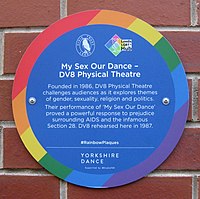History
Leeds Pride first took place in August 2006 (then called Leeds Gay Pride) although there had been previous Pride events in Leeds, such as Hyde Out in 2000 and in the few years before the first Leeds Pride, an informal picnic on Woodhouse Moor. Leeds Pride was supported by the city council and local business with 6,500 attending. [2] In 2009 the numbers attending the event had almost doubled, to 12000, with over 1,000 participating in the parade. [3] In its tenth year (2016) the name had changed to Leeds Pride [4] and it had over 40,000 people in attendance, with the figure expected to grow in year on year. [5]
The 2023 Leeds Pride took place on Sunday 6 August with 175 organisations taking part in the parade, and over 75,000 people in attendance, making it the biggest Leeds Pride ever. [1]
A 2024 policy change caused controversy after the organisation changed their parade guidance to include comments about “specific individuals, beliefs, or political opinions are strictly forbidden". Breaking of this rule could lead to removal from the parade. The activist group Dirty Dykes made a public statement on their Instagram explaining that they wouldn't be attending the event in 2024 due to this policy change. The parade policy was subsequently changed, but Dirty Dykes pointed out this only occurred after parade applications had already closed. [6]
This page is based on this
Wikipedia article Text is available under the
CC BY-SA 4.0 license; additional terms may apply.
Images, videos and audio are available under their respective licenses.
















